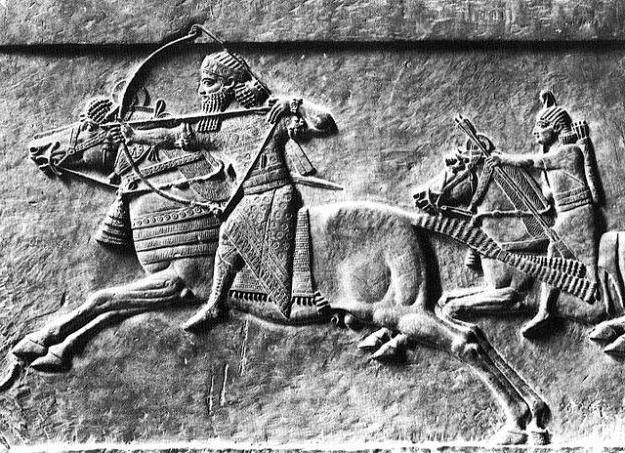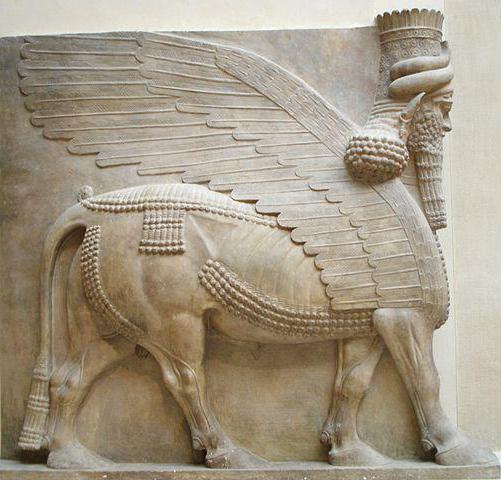The first empire of the Ancient World was Assyria. This state existed on the world map for almost 2000 years - from the XXIV to VII century BC, and about 609 BC. e. ceased to exist. The first mention of Assyria was discovered by ancient authors such as Herodotus, Aristotle and others. The Assyrian kingdom is also mentioned in some books of the Bible.
Geography
The Assyrian kingdom was located in the upper reaches of the Tigris River and stretched from the lower reaches of Lesser Zaba in the south to the Zagras mountains in the east and the Masios mountains in the north-west. At different times in its existence, it was located on the lands of such modern states as Iran, Iraq, Jordan, Israel, Palestine, Turkey, Syria, Cyprus and Egypt.
For centuries of history, not one capital of the Assyrian kingdom is known:
- Ashur (the first capital, was 250 km from modern Baghdad).
- Ekallatum (the capital of Upper Mesopotamia, was in the middle reaches of the Tigris).
- Nineveh (located on the territory of modern Iraq).
Historical periods of development
Since the history of the Assyrian kingdom takes too much time, the era of its existence is conditionally divided into three periods:
- Old Assyrian period - XX -XVI centuries BC.
- The Central Assyrian period - XV-XI centuries BC.
- New Assyrian kingdom - X-VII century BC.
Each of the periods was characterized by its domestic and foreign policy of the state, monarchs from various dynasties stood in power, each subsequent period began with the rise and heyday of Assyrian statehood, a change in the geography of the kingdom and a change in foreign policy guidelines.
Old Assyrian period
Assyrians entered the Euphrates River in the middle of the 20th century. BC e., these tribes spoke Akkadian. The first city they built was Ashur, named after his supreme deity.
During this period, a single Assyrian state did not yet exist, therefore Ashur, who was a vassal of the kingdom of Mitania and Cassite Babylonia, became the most powerful king. Nome retained some independence in the internal affairs of the settlements. Several small rural settlements headed by elders belonged to Ashursky Nom. The city developed quite quickly due to its favorable geographical location: it was through it that the trade routes from the south, west and east passed.
It is not customary to talk about the monarchs ruling during this period, since the rulers did not have all the political rights characteristic of those holding such a status. This period in the history of Assyria was singled out by historians for convenience as a prehistory of the Assyrian kingdom. Before the fall of Akkad in the XXII century BC Ashur was part of it, and after its disappearance became independent for a short period of time, and only in the XXI century BC. e. was captured by ur. Only after 200 years, power passes to the rulers - Ashurites, from that moment a rapid growth of trade and commodity production begins. However, this situation within the state did not last long, and after 100 years, Ashur loses its significance as a central city, and one of the sons of the ruler Shamst-Adad becomes its viceroy. Soon the city came under the rule of King Babylon Hammurabi, and only around 1720 BC. e. begins the gradual flowering of an independent Assyrian state.
Second period
Starting from the 14th century BC, Assyrian rulers are already called kings in official documents. Moreover, when they turn to the pharaoh of Egypt, they say "Our brother." During this period, active military colonization of the land took place: incursions were carried out on the territory of the Hittites, raids on the Babylonian kingdom, in the cities of Phenicia and Syria, and in 1290-1260. BC e. the territorial design of the Assyrian empire ends.

A new upsurge of the Assyrian wars of conquest began under King Tiglathpalasar, who was able to capture Northern Syria, Phenicia, and part of Asia Minor; moreover, the king went on ships several times to the Mediterranean Sea to show his superiority over Egypt. After the death of the conquering monarch, the state begins to decline, and all subsequent kings can no longer save the previously occupied lands. The Assyrian kingdom was crowded out into its indigenous lands. Documents of the period XI-X centuries BC e. not preserved, indicating a decline.
New Assyrian Kingdom
A new stage in the development of Assyria began after the Assyrians managed to get rid of the Aramaic tribes that came to their territory. The state created during this period is considered to be the first empire in the history of mankind. The prolonged crisis of the Assyrian kingdom was able to stop the kings of Adad-Nirari II and Adid-Nirari III (it is with his mother Semiramis that the existence of one of the 7 wonders of the world - the Hanging Gardens) is connected. Unfortunately, the next three kings could not resist the blows of an external enemy - the kingdom of Urartu, and pursued an illiterate domestic policy, which significantly weakened the state.
Assyria under Tiglapalasar III
The real rise of the kingdom began in the era of King Tiglapalasar III. In power in 745-727 BC e., he was able to capture the lands of Phenicia, Palestine, Syria, the Damascus kingdom, it was during his reign that a long-term military conflict with the state of Urartu was resolved.

Good luck in foreign policy due to the implementation of domestic political reforms. Thus, the king began the forcible resettlement of inhabitants from the occupied states, along with families and property, to his lands, which led to the spread of the Aramaic language throughout Assyria. The tsar solved the problem of separatism within the country, dividing large areas into many small ones, headed by governors, thus preventing the emergence of new dynasties. The tsar also set about reforming the army: the army, consisting of militias and military colonists, was reorganized into a professional regular army, receiving a salary from the treasury, new types of troops were introduced - regular cavalry and sappers, special attention was paid to organizing the intelligence and communications service.
Successful military campaigns allowed Tiglathpalasar to create an empire that stretched from the Persian Gulf to the Mediterranean Sea, and even crowned himself as the king of Babylon - Pula.
Urartu - the kingdom (Transcaucasia), into which the Assyrian rulers invaded
The kingdom of Urartu was located on the territory of the Armenian Highlands and occupied the territory of modern Armenia, eastern Turkey, northwestern Iran and the Nakhichevan Autonomous Republic of Azerbaijan. The heyday of the state came at the end of IX - the middle of the VIII century BC, the decline of Urartu was largely contributed to by the war with the Assyrian kingdom.
Having received the throne after the death of his father, King Tiglathpalasar III sought to regain control of the Asia Minor trade routes to his state. In 735 BC e. in a decisive battle on the west bank of the Euphrates, the Assyrians were able to defeat the army of Urartu and advance deep into the kingdom. Monarch Urartu Sarduri escaped and soon died, the state was in a deplorable state. His heir, Rus I, was able to establish a temporary truce with Assyria, which was soon broken by the Assyrian king Sargon II.
Taking advantage of the fact that Urartu was weakened by the defeat received from the Cimmerian tribes, Sargon II in 714 BC. e. destroyed the Urartian army, and thus Urartu and its dependent kingdoms fell under Assyrian rule. After these events, Urartu lost its significance on the world stage.
The politics of the last Assyrian kings
The heir to Tiglathpalasar III could not hold in his hands the empire founded by his predecessor, and over time Babylon declared its independence. The next king, Sargon II, in his foreign policy did not limit himself to owning only the kingdom of Urartu, he was able to return Babylon to the control of Assyria and was crowned as the Babylonian king, he also managed to suppress all rebellions that arise on the territory of the empire.

The reign of Sinaheherib (705-680 BC) was characterized by a constant confrontation between the king and the priests and the townspeople. During his reign, the former king of Babylon again tried to restore his power, this led to the fact that Sinacheherib brutally cracked down on the Babylonians and completely destroyed Babylon. Dissatisfaction with the king’s policies led to the weakening of the state and, as a result, outbreaks of uprisings, some states regained their independence, and Urartu regained a number of territories. Such a policy led to the assassination of the king.
Having received power, the heir to the murdered king Asarhaddon first of all took up the restoration of Babylon and establishing relations with the priests. As for foreign policy, the king was able to repel the invasion of the Cimmerians, suppress the anti-Assyrian uprisings in Phenicia and take a successful campaign in Egypt, which resulted in the capture of Memphis and the ascension to the throne of Egypt, but the king was not able to hold this victory due to an unexpected death.
The last king of Assyria
The last strong king of Assyria was Ashurbanipal, known as the most competent ruler of the Assyrian state. It was he who in his palace assembled a unique library of clay tablets. The time of his reign was characterized by a constant struggle with vassal states wishing to regain independence. Assyria during this period fought with the kingdom of Elam, which led to the complete defeat of the latter. Egypt and Babylon wanted to regain independence, but as a result of numerous conflicts they did not succeed. Ashurbanipal succeeded in extending his influence to Lydia, Media, Phrygia, and defeating Thebes.
The death of the Assyrian kingdom
The death of Ashurbanipal marked the beginning of trouble. Assyria was defeated by the kingdom of Media, and Babylon gained independence. The combined armies of the Medes and their allies in 612 BC e. the main city of the Assyrian kingdom, Nineveh, was destroyed. In 605 BC e. under Karkemish, the Babylonian heir Nebuchadnezzar defeated the last military units of Assyria, thus the Assyrian empire was destroyed.
The historical significance of Assyria
The ancient Assyrian kingdom left behind many cultural and historical monuments. Many bas-reliefs with scenes from the life of kings and nobles, six-meter sculptures of winged gods, a lot of ceramics and jewelry have been preserved to our time.
A great contribution to the development of knowledge about the Ancient World was made by the discovered library with thirty thousand clay tablets of King Ashurbanipal, which collected knowledge on medicine, astronomy, engineering, and even the Great Flood was mentioned.
Engineering was at a high level of development - the Assyrians were able to build a canal-water supply system and aqueduct 13 meters wide and 3,000 meters long.
The Assyrians were able to create one of the strongest armies of their time, they were armed with chariots, rams, spears, soldiers used trained dogs in battles, the army was well equipped.
After the fall of the Assyrian state, Babylon became the heir to centuries-old achievements.